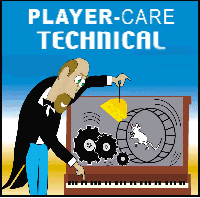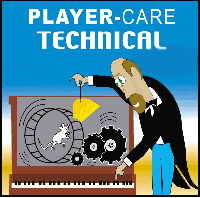
|

|

|

|

|

|
| Home | Manuals | Supplies | Search | Consult | Contact | Testing | Service |


|
|
These valves usually break apart easily. Using an X-Acto #11 blade, start at the mounting surface and pull the blade into the seam on the valve. The top should pop right off. The bottom section comes apart, and usually, the leather pouch is destroyed. Re-pouch the valve using only German Tan Pneumatic or Robert Morton type leather available from Columbia. Do not use Hairsheep or Kangaroo! Do not seal the leather, as the bleed is only thirty-thousandths which indicates some pouch porosity was taken into account. You can replace the valve with the original 3/8" inch sponge neoprene or make up another valve of your own choosing. Reassemble the valve using any good plastic glue, and clamp tightly until dry. I like to use a water-based plastic glue, as the bond will not dissolve into the plastic and the valve can be separated easily in the future. Written by Nathan "Skip" Woodhull Opening a Plastic Aeolian Block Valve
In follow-up emails, Skip and I discussed a few other things. Below are portions of those emails which are applicable to this procedure.
My friend that works in the shop with me had an interesting idea. He ground down a spade drill bit, put it in the drill press and using the press function put it in the seam of the valve and split it easily with no danger to ones fingers. It doesn't surprise me as he was for years a machine repairman in a variety of industries and he comes up with some great ideas. Hi John, Since we can now separate the valve, it becomes possible to experiment with many different valve designs. I tried one using closed cell sponge neoprene, one sixteenth thick, self stick. I sandwiched a five-eigths fibre disc between two sponge neo punchings. By adding the appropriate thickness of leather, the valve throw could be adjusted quite accurately. Since this valve design is rigid there is no "cupping" of the valve as it leaves the inner seat and response can be greatly improved as well as clearance reduced. I find if you coat the disc with Formica 140 or any high solvent contact cement, the sponge neo will adhere so tenaciously that it will be impossible to remove it intact. I'll keep you informed of any improvements that I discover. Hi Skip, I noticed that it looks like you glued tan pneumatic leather to the top of the valves in the device you sent me. Is that true? I started doing that in the early 90's to reduce the valve clearance and improve performance. It's interesting that you mention 'cupping', which is a term that is seldom heard when talking about valves. Personally, I think the basic design of the valve stem pretty much eliminates cupping in the case of the Aeolian block, but making the facing rigid would certainly reduces cupping to zero. What would concern me more about your design is the added weight of the fiber disc. I'd be curious to know how much weight it adds in terms of a percentage of the original configuration. Anything that adds weight to the valve will reduce the responsiveness and repetition rate by some amount. Such was the case with the units that Denis produces. After making a couple of changes, we reduced the weight by 32%. Now his blocks work easily on less than two inches of vacuum. This is especially desirable considering the distance between the trackerbar and the stack in an Aeolian player, but it's even more beneficial in auto-rewind units (like the ones that were made by Player Piano Co, which used Wurlitzer-type block valves) that are mounted in the bottom half of the piano. John, Yes I did glue tan pouch leather on the top of the valve to reduce clearance. After reading your statement about adding weight, I have decided to just glue the leather onto the top of the sponge neo valve. By using glue to cement this leather to the sponge neo, one would expect that this would "stiffen" the valve and also eliminate or greatly reduce "cupping". Perhaps a short definition of "cupping" is in order. As the pouch pushes the valve upward, the inner circumference is lifted first and the outer rim of the valve tends to hang on ever so slightly before it also lifts. This is what I consider "cupping". Practically all old players used a rigid piece onto which the valve surface was glued and this made these valves heavier. It dosen't seem to me that this was a problem that greatly affected performance. Think about the old Aeolian cross seat valves with that heavy wooden piece that was used in the pre-1923 cross seat valves. Those valves were very heavy but were only energized by a one inch working diameter pouch. Some rebuilders claim that they can get those valves to work at ridiculously low vacuum levels. BTW I don't buy it! Larry Givens and I had a long discussion about setting the minimum playing volume on a Duo-Art Grand. We finally agreed that to rigidly adhere to the instructions on the test roll was foolish, if it resulted in poor performance of the piano. Same can be said for the Ampico. Please keep me informed as to your progress working with these valves. I am an old dog but like to think I can learn new tricks! God bless and keep you, Skip Woodhull Hi Skip, We agree on the definition of cupping, and we agree on setting the vacuum level in reproducing players based on performance, not a number in a book. In fact, I don't see where we disagree... :-) The truth is that the new replacement block valves are much faster than any piano action, and the limiting factor, in terms of speed, is the striker pneumatic. Performance can be improved by adding return springs to the bellows, as Duo-Art found out. But all of this is almost a mute point when dealing with the modern Aeolian player because only a tiny percentage of owners would ever notice the difference, and the difference would only be noticeable when foot-pumping at very low vacuum levels. The vast majority of users just hit the power switch and let the vacuum pump do the work... ;-) |

![]() ..To
The Top of this Page . . . . . . . . . . .
..To
The Top of this Page . . . . . . . . . . . ![]() ..To The HOME Page
..To The HOME Page
|
Since "Player-Care" is an internet business, I prefer that we correspond via E-Mail (click here to fill out the 'Request Form'). However, if I'm not in the middle of some other activity, you can reach me at 732-840-8787. But please understand that during the hours from 8AM-5PM EST (Mon-Sat), I'm generally quite busy. So, I probably won't answer the phone. If you get the answering machine, please leave a detailed message stating the reason for your call. Also, repeat your name and phone number clearly and distinctly. By necessity, I prioritize everything in my life. And, if you call and just leave your name and number, and ask me to call you back, it might be a day or two before I return your call. Why? Because I don't know why you want me to call and I might not be prepared to assist you in an effective and efficient manner. If you leave me an E-Mail address (which I prefer), spell it out phonetically. The more you do to help me, the more I can help you in return. Don't rush. You have four minutes to record your message. |
|
407 19th Ave, Brick, NJ, 08724 Phone Number 732-840-8787 (Voicemail Only, No Texts) |
